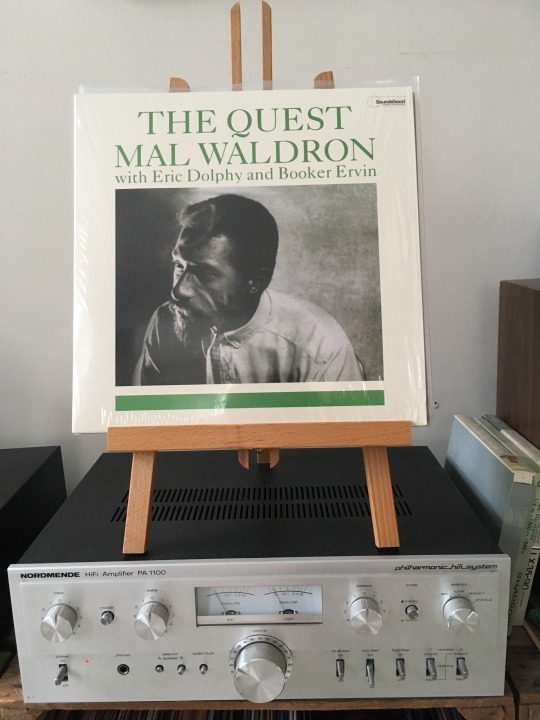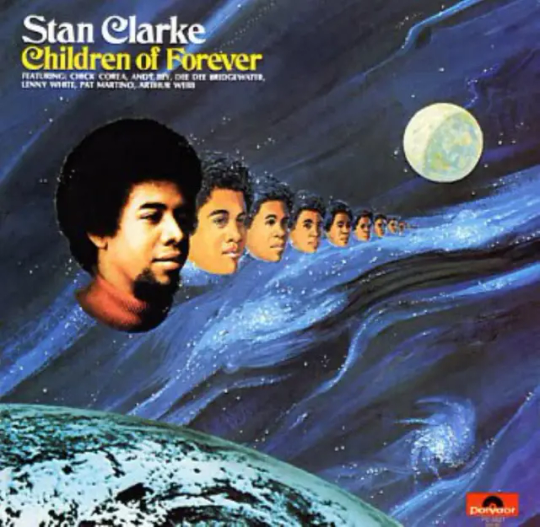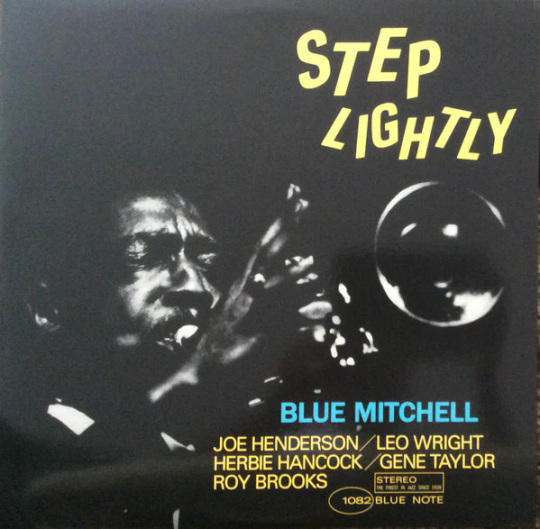#booker ervin
Explore tagged Tumblr posts
Text


TODAY’S FROZEN MOMENT - 65th Anniversary
This amazing shot was taken just after midnight and in the first moments of the new year, at the Five Spot, a New York jazz club. January 1st, 1959
Here was the legendary Charles Mingus on his bass, playing with Horace Parlan on piano, saxophonists Booker Ervin and John Handy, and Roy Haynes on drums….
In front of Mingus’ bass sits devoted fan Orson Welles…
Photos by Dennis Stock
(Mary Elaine LeBey)
#jazz#Dennis Stock#Charles Mingus#Horace Parlan#Booker Ervin#John Handy#Roy Haynes#Jazz history#Mary Elaine LeBey
19 notes
·
View notes
Photo

Charles Mingus - Mingus Ah Um. 1959 : Columbia CL 1370.
! acquire the album ★ attach a coffee !
#jazz#hard bop#bop#jazz bass#charles mingus#1959#columbia#horace parlan#booker ervin#teo macero#1950s#1950s Jazz#essential jazz#essential album
67 notes
·
View notes
Text

[yt]
2 notes
·
View notes
Text
Horace Parlan: The Pianist Who Turned Adversity into Art
Introduction: Horace Parlan (1931–2017) was an extraordinary jazz pianist and composer whose life and career were defined by resilience, innovation, and a singular musical voice. Despite the challenges posed by polio, which left his right hand partially disabled, Parlan became a defining figure in hard bop, post-bop, and avant-garde jazz. His artistry, both as a soloist and collaborator,…
#Ahmad Jamal#Al Harewood#Archie Shepp#Blue Parlan#Blues & Roots#Booker Ervin#Bud Powell#Charles Mingus#Charles Mingus&039; Jazz Workshop#Dannie Richmond#Dexter Gordon#Doin&039; Allright#Erroll Garner#George Tucker#Goin&039; Home#Grant Green#Horace Parlan#Jazz History#Jazz Pianists#Mary Lou Williams#Mingus Ah Um#Movin&039; & Groovin&039;#My Little Brown Book#Sam Jones#Speakin&039; My Piece#Stanley Turrentine#Swing Low#That&039;s It!#Trouble in Mind#Up & Down
2 notes
·
View notes
Text
Booker Ervin - Blues For You(Vinyl)
#music#vinyl#records#jazz#レコード#ジャズ#newjazzthings#new jazz things#record#ジャズレコード#アナログレコード#アナログ#音楽#vinyl records#vinylcollection#vinylcommunity#vinylcollector#enja#Booker Ervin#SoundCloud
5 notes
·
View notes
Text

It should be more widely recognised as a jazz classic. Groovy, avant, gentle and fabulous!
2 notes
·
View notes
Photo
One of the Boss Tenors.

AllMusic Staff Pick: Booker Ervin Structurally Sound
Mixing the dusky romanticism of Dexter Gordon and the progressive tonal ideology of John Coltrane, Booker Ervin is often filed under “A” for amalgam alongside other overlooked tenor masters such as Tina Brooks and Hank Mobley. Structurally Sound is perhaps not Ervin’s most provocative album, but a solid and tasty endeavor featuring the suspended chord sounds popularized by McCoy Tyner during the late ‘60s.
- Matt Collar
9 notes
·
View notes
Text

CHARLES MINGUS E ORSON WELLES
CAPODANNO AL FIVE SPOT
Capodanno 1959, seduto in prima fila, proprio sotto il contrabbasso di Mingus c’era Orson Welles, quasi un alter ego del jazzista, per genialità, esuberanza, fierezza, complessità. E anche per le tante disavventure artistiche. Per Mingus era un idolo, lo seguiva dai tempi radiofonici di The war of worlds, adorava Quarto potere (dove in una scena c'era il suo amico d'infanzia Buddy Collette che suonava il sax in una festa sulla spiaggia), ammirava il suo modo di vestire, il suo impegno politico (sempre in prima linea per la difesa dei diritti civili, il suo Macbeth tutto nero è del 1936), la sua voce (“mi ricorda Coleman Hawkins. Potevi sentirla a un miglio di distanza”). E non era il solo jazzista a essere stato sedotto dalla voce radiofonica di Orson Welles, anche Miles Davis lo citava come un’influenza sul suo modo di suonare: “Fraseggio, tono, intonazione: tutte queste cose possono avere come modello un maestro della parola”.
Il 1959 sarà un anno d’oro del jazz per quantità, qualità, creatività. Al Five spot, piccolo, fumoso, maleodorante locale di Bowery, scelto come luogo di riferimento da artisti e intellettuali, l'anno comincia con un formidabile double bill: sono di scena, uno dopo l’altro, Sonny Rollins, alla testa di un trio con il bassista Henry Grimes e con il batterista Pete La Rocca, e Charles Mingus con il pianista Horace Parlan, il batterista Roy Haynes (che sostituisce il fedelissimo Dannie Richmond arrestato) e i sassofonisti Booker Ervin e John Handy. È la prima sera dell���anno, ma nel club di Bowery dei fratelli Joe e Iggy Termini è anche l’ultimo impegno di quel prestigioso, favoloso cartellone con Mingus molto irrequieto per tutta la scrittura. Aveva appena registrato la musica per il film di John Cassavetes Shadows, una colonna sonora bocciata nel rimontaggio finale (la stessa cosa sarebbe successa anni dopo con Todo modo di Petri), aveva ripreso i suoi musicisti brutalmente e una volta aveva minacciato violentemente i clienti di un tavolo che, durante il suo set, non smettevano di parlare. Oltretutto ogni sera tendeva ad allargare il suo set e Sonny si inferociva, talvolta rifiutandosi di suonare. Ma era un gran clima, entusiasmante e effervescente. Rollins era in un momento di transizione, alla vigilia di un ritiro clamoroso per rinnovare il linguaggio del suo sax tenore con il leggendario e solitario corso di aggiornamento stilistico sul ponte di Williamsburg: «In un posto tranquillissimo, un angolo morto che oggi sarebbe impossibile ritrovare con il traffico che c’è» il suo racconto, dove poteva esercitarsi liberamente.
Anche Welles, come Mingus, era reduce da una delusione cinematografica: la Universal gli aveva tolto di mano la post-produzione del nuovo film, L’infernale Quinlan, ne aveva tagliato una ventina di minuti e aveva fatto girare nuove scene, modificando il primo montaggio. Più o meno nello stesso periodo era finito in soffitta un documentario intitolato Viva Italia (Portrait of Gina) perché Gina Lollobrigida aveva messo un veto, non gradendo il suo ritratto di giovane attrice ambiziosa e la Abc tv lo aveva bocciato ritenendolo cosi poco ortodosso da non poter essere trasmesso. Era un film di mezz’ora scarsa sull’Italia, paese che Orson ha frequentato per 20 anni (la terza moglie è stata l’attrice italiana, Paola Mori). Dopo un lungo oblio (Orson aveva perduto l'unica copia esistente all'Hotel Ritz di Parigi) è stato riscoperto nel 1986, proiettato al festival di Venezia ma poi di nuovo bandito su intervento della Lollobrigida.
La presenza del regista di Quarto potere al Five spot non era casuale
Nel club di Bowery si poteva incontrare chiunque, da Jack Kerouac che leggeva le sue poesie, alla mitica baronessa Pannonica de Koenigswater scesa dalla sua Rolls Royce, a William de Kooning che voleva respirare la libertà del jazz, a Leonard Bernstein che si divertiva a curiosare nella notte, allo scrittore Norman Mailer con la sua passione per quella musica. Ma la musica da sempre è stata una grande passione di Welles. La mamma pianista gli aveva fatto prendere lezioni di piano e violino e Orson aveva anche mostrato un certo talento, tanto da essere considerato un ragazzo prodigio. In gioventù era stato un grande sostenitore del jazz di New Orleans, ma sicuramente ammirava Charles Mingus per la sua musica e la sua personalità, il suo impegno, il suo agire tellurico.
(Marco Molendini)
Non potevo non condividerlo.
Due miei ingombranti miti nella stessa foto, nello stesso locale, nello stesso articolo.
26 notes
·
View notes
Text
"Al's In" by Booker Ervin came on while I was reading A and Quinn running away. Works really well, especially if you read it as "A.I.'s In." The perfect scene for when you're is running through a chaotic and meaningless future while your second-skin lies to your parents and rationalizes their own burgeoning rebellious streak.
2 notes
·
View notes
Text

Booker Ervin – The Song Book
The Song Book is an album by American jazz saxophonist Booker Ervin featuring performances recorded in 1964 for the Prestige label. Ervin and his quartet (with pianist Tommy Flanagan, bassist Richard Davis and drummer Alan Dawson) come up with fresh interpretations of the warhorses. Booker Ervin never sounded like anyone else. (Scott Yanow/AllMusic).
12 notes
·
View notes
Video
More from Biss Tenor Bokker Ervin!
youtube
booker ervin – the trance
8 notes
·
View notes
Text















DIGGING DEEPER
Great Jazz Records No One Ever Talks About
These days you see a lot of websites, and YouTube videos where people discuss their favorite records, and it seems to me everyone talks about the same records by the same artists. When I was building my Jazz collection, I often picked up things based on the musicians playing on the album, or maybe the label the record was on, and sometimes I just liked the look of the cover. Because of that, I own a lot of Jazz titles that are "one-offs" in my collection, or are lesser known titles by artists with huge catalogs. I'd like to do this as a regular feature with all genres. I have no idea how easy these might be to find. I'll leave that to you. But I can vouch for all of them. They're all in my collection, and they're going to stay. I wanted to call attention to them. Check them out. You might hear something you love.
The Spice of Life - Marlena Shaw
West Coast 1945-47 - Howard McGhee
Nonet + Octet - Oscar Pettiford
Contemporary Jazz - Branford Marsalis
Ornette Coleman Anthology - Aki Takase and Silke Eberhard
Broken Shadows - Tim Berne
Light Blue - Arthur Blythe
Children of Forever - Stan Clarke
Groovin' High - Booker Ervin
Milestone Jazzstars in Concert - Sonny Rollins, Ron Carter & McCoy Tyner
Back To The Tracks - Tina Brooks
Sweet Rain - Stan Getz
Step Lightly - Blue Mitchell
It's Not Up To Us - Byard Lancaster
Very Cool + Tranquility - Lee Konitz
5 notes
·
View notes
Text
5/31 おはようございます。 Mongo Santamaria / Images JMVS-92 等更新しました。
Johnny Hartman / All of Me bcp6014 Ann Richards Stan Kenton / Two Much t1495 Alma Cogan / Alma Cogan pmes535 Bernard Peiffer / Bernie’s Tune Mg36080 Booker Ervin / Setting the Pace Prst7455 Joao Gilberto Caetano Veloso Gilberto Gil Maria Bethania / Brasil BSK3613 Chipmunks / Christmas With The Chipmunks LM-1071 Last Poets / Right On COL-6500 Annette Peacock / I Have No Feelings IRONIC Deodato / Knights Of Fantasy BSK3321 Flora Purim & Airto / Humble People GW-3007 Mongo Santamaria / Images JMVS-92 Mongo Santamaria / Mongo ‘70 sd1567 Mongo Santamaria / Greatest Hits cs1060 Jimmy Ponder / All Things Beautiful Lrc9322 New Birth / Comin From All Ends Apl10494 New Birth / Behold the Mighty Army Bs3071 Loose Ends / A Little Spice MCA-5588

~bamboo music~
530-0028 大阪市北区万歳町3-41 シロノビル104号
06-6363-2700
2 notes
·
View notes
Text
Booker Ervin: The Tenor Saxophonist Who Brought the Blues to Jazz
Introduction: Booker Ervin’s tenor saxophone voice was one of the most distinctive in jazz. He combined the raw emotional intensity of the blues with the sophistication of modern jazz, creating a style that was both deeply rooted in African American musical traditions and forward-thinking in its complexity. Though he was overshadowed by contemporaries like John Coltrane and Sonny Rollins,…
#Alan Dawson#Blues & Roots#Booker Ervin#Buddy Tate#Charles Mingus#Charlie Parker#Dexter Gordon#Jaki Byard#Jazz History#Jazz Portraits: Mingus in Wonderland#Jazz Saxophonists#John Coltrane#Lester Young#Mingus Ah Um#Richard Davis#Sonny Rollins#The Blues Book#The Freedom Book#The Song Book#The Space Book
2 notes
·
View notes
Text
BOOKER ERVIN / LAMENT FOR BOOKER ERVIN
#music#vinyl#records#jazz#レコード#newjazzthings#ジャズ#new jazz things#record#音楽#ジャズレコード#レコード通販#アナログレコード#アナログ#オリジナル#vinylrecord#vinyl records#vinylcollection#vinylcollector#vinylcommunity#Booker Ervin
2 notes
·
View notes
